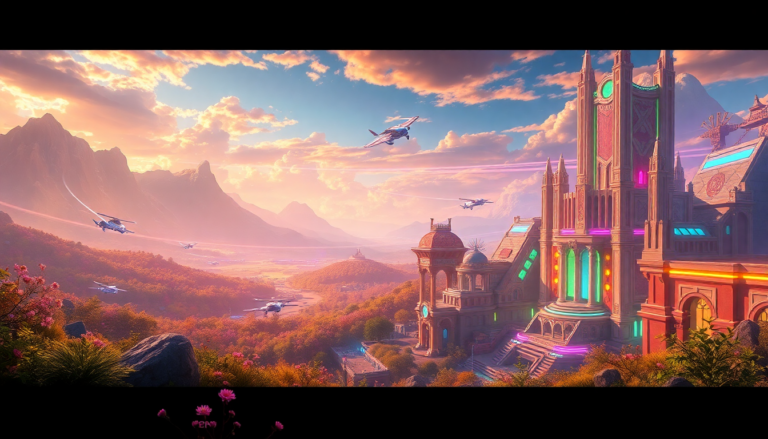Argomenti trattati
When it comes to video games, the term ‘art design’ often takes a backseat to discussions about graphics. Yet, the visual expression of a game—its colors, shapes, animations, and overall aesthetic—can profoundly impact how players feel and interact with the virtual worlds they enter. It’s not merely about how realistic a game looks; it’s about how it resonates with players on an emotional level, creating an atmosphere that lingers long after the console is turned off.
The role of art design in shaping mood and atmosphere
Art design serves as the backbone of a game’s identity, setting the tone before the player even begins to engage with the narrative. From the muted colors of a dystopian city to the vibrant chaos of a post-apocalyptic landscape, the choices made in art direction can convey a message that words alone cannot capture. For instance, take the 2009 game set in Nazi-occupied Paris, where players experience a stark black-and-white world that slowly bursts into color as they liberate neighborhoods. This clever use of color not only illustrates progress but also immerses players in an emotional journey, signaling hope amid oppression. It’s a brilliant example of how art can communicate themes and emotions without a single line of dialogue.
Examples of revolutionary art direction
Games like No Man’s Sky and Elden Ring showcase how art design can transform gameplay into an unforgettable experience. In No Man’s Sky, players are greeted with surreal landscapes painted in vibrant colors, creating a dreamlike atmosphere that feels alive and otherworldly. The art direction here is not about realism but about crafting a unique, immersive environment that invites exploration. Each new solar system is a visual feast, filled with uncharted planets and procedurally generated creatures, encouraging players to lose themselves in the beauty of the unknown.
On the other hand, Elden Ring takes players through a world steeped in history and decay, where every structure and character tells a story of a grand past. The art design reinforces the feeling of a world that has seen better days, filled with ruins and remnants of a once-mighty civilization. It’s this attention to detail that makes players feel as if they are walking through a living, breathing history, rather than just a virtual playground.
Art design as a narrative device
Art design does more than just create a visually appealing environment; it also serves as a narrative device. In Death Stranding, the landscape is a character in itself, reflecting themes of isolation and connection. Hideo Kojima’s vision for this post-apocalyptic world utilizes stark, sweeping vistas that evoke a sense of solitude and distance. The design choices emphasize the weight of the journey, where every step feels significant. The tangible objects in the world—bridges, zip-lines, and vehicles—are not just gameplay mechanics; they symbolize the human desire to reconnect and rebuild.
Similarly, in Ghost of Tsushima, the art direction is steeped in cinematic beauty, capturing the essence of a samurai film. The dynamic weather, changing seasons, and stunning landscapes create an immersive experience that feels like stepping into a painting. The game’s visuals not only enhance the narrative but also guide player actions—like how the wind subtly directs players toward objectives. This integration of art and gameplay creates a seamless experience that feels both intentional and rewarding.
The emotional impact of visuals
Players often recall their experiences based on the emotions invoked by a game’s visuals. Whether it’s the haunting beauty of Red Dead Redemption 2, where sunsets and foggy nights create a tranquil yet melancholic atmosphere, or the chaotic vibrancy of Sunset Overdrive, where colors explode across the screen, each game uses art design to create memorable moments. The emotional resonance is palpable; for instance, during a tense mission in Red Dead Redemption 2, the flickering light from a fire juxtaposed against the dark night reflects the internal struggles of the characters, deepening the player’s connection to the story.
In stark contrast, the exaggerated art style of Blood Dragon serves to amplify the absurdity and humor of its narrative, wrapping players in a vibrant, neon-drenched world that feels like a tribute to classic action films. This playfulness is a testament to how art design can shape not only the aesthetic but also the overall tone of the game.
Conclusion: the future of art in gaming
As the gaming industry continues to evolve, the role of art design will only become more critical. With advancements in technology, we can expect even more breathtaking visuals that push the boundaries of creativity. Games will not just serve as entertainment; they will become immersive experiences that challenge perceptions and evoke deep emotional responses. With every new title, the potential for art design to enrich storytelling and gameplay grows, promising a future where players are not just participants but active players in a beautifully crafted narrative world.

